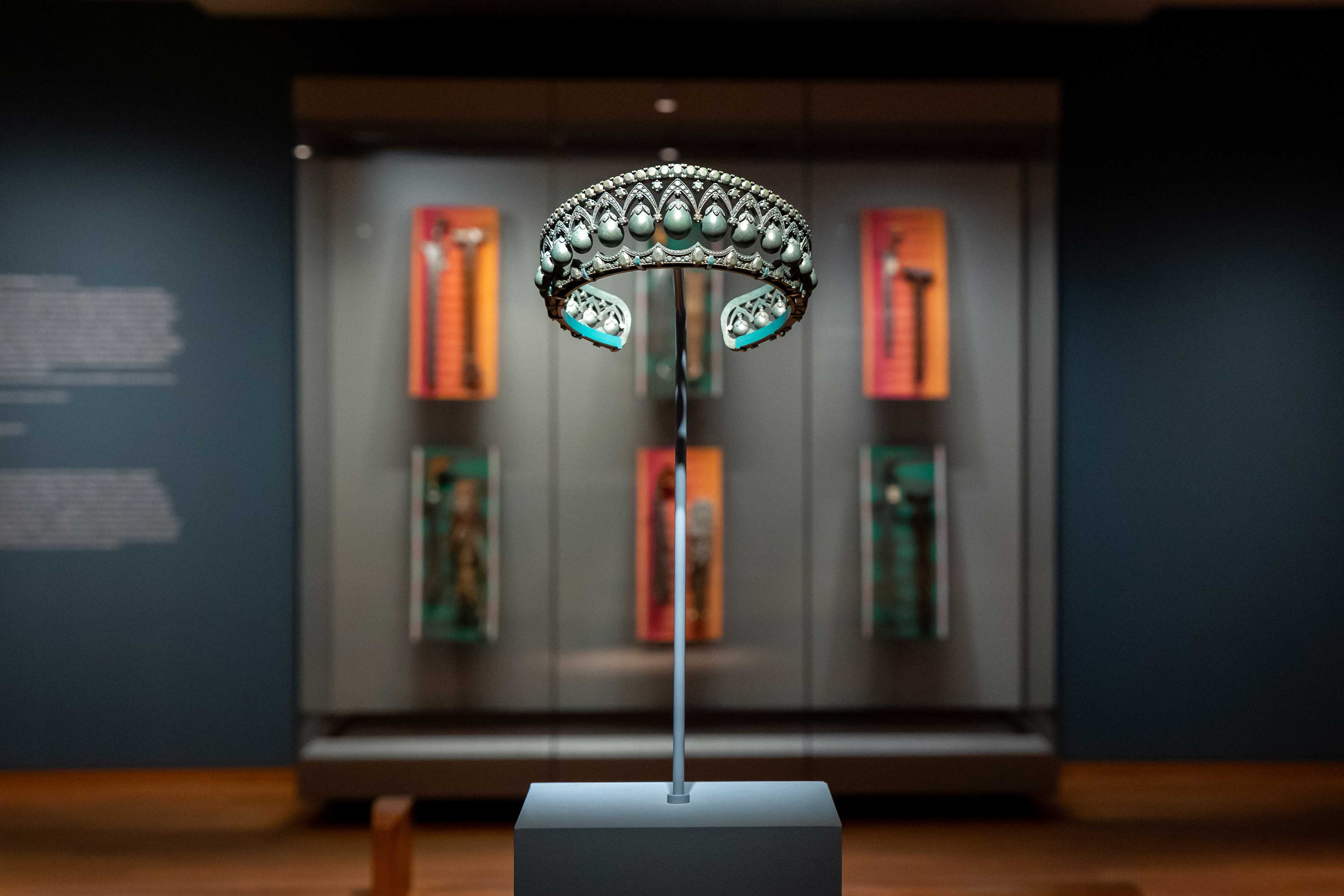


©Ashmolean Museum, University of Oxford Photos: ©Hannah Pye Works: ©Pio Abad
Ashmolean Museum, Beaumont St, Oxford OX1 2PH
10 February – 8 September 2024
‘To those sitting in the Darkness’ by Pio Abad is the second iteration of Ashmolean NOW, launched in 2023, to support early to mid-career artists to critically and creatively engage with the museum and University of Oxford’s holdings.
Presented downstairs in the Ashmolean’s Gallery 8, Abad selected artefacts, textiles, etchings and drawings from the museum and the University of Oxford’s vast collections - some on display to the public for the first time. Juxtaposing historic objects, collected during the colonial period alongside new ink and pencil drawings, engravings, and sculptures, Abad explores how personal poly-cultural migrant stories, are intertwined with themes of family, politics, colonial histories and cultural loss.
The exhibition title refers to American writer Mark Twain’s essay ‘To the Person sitting in Darkness’ (1901), a satirical critique of Imperialism and, by extension to the US conquest of the Philippines, where Abad was born and raised before studying at Glasgow School of Art and the Royal Academy Schools in London
The starting point for the exhibition is Dan Hicks’ book ‘The Brutish Museum. The Benin Bronzes, Colonial Violence and Cultural Restitution’ (London, 2020) which Abad read during lockdown. In the book, Hicks advocates for the need to decolonise museums and seek out new ways to communicate the immensurable cultural loss that is inherent to the history and provenance of the Benin Bronzes.
Abad’s series of fourteen black and white drawings, 1897.76.36.18.6, juxtaposes everyday objects from his London residence (located on the top floor of the Royal Arsenal in Woolwich) alongside Benin Bronzes. This contrast is made more pertinent through the history of the Royal Arsenal as a storage location that served the British Army and Navy throughout the 19th Century.
The elaborate and layered drawings of the African artefacts and Abad’s personal objects can be seen as signifiers for cultural discontinuity and loss within world history. A photograph of Abad’s late mother, who is laid to rest in Batanes in the northern part of the Philippines, quietly reflects the artist’s own experience of displacement and grief.
Near to Abad’s ink and screenprint drawings we encounter a watercolour sketch titled Sacrificial altar, Benin from 1897, which Abad found in the journal of George Le Clerc Egerton (Chief of Staff of the 1897 Benin expedition). Alongside detailed written documentation of the raids, Le Clerc Egerton painted a Benin altar with 8 bronze heads and ceremonial bells lying in what appears to be a pool of dried blood. An essay written by Abad in the accompanying publication presents the dark histories that are embedded in museum objects today: 43 Benin Bronzes currently in the collection of the Pitt Rivers are on loan from the Dumas Egerton Trust.
I am singing a song that can only be borne after losing a country, 2023, is a large-scale red pencil drawing, that depicts the contours, lines, cracks and patterns on the underside of ‘Powhatan’s Mantle’ (1638) to scale. The cloak, made of deer skin, is part of the founding collection of the Ashmolean Museum. It was acquired by Elias Ashmole before 1682 and is usually the centre piece of the room adjacent to Gallery 8. Signifying the first encounter between Native Americans and British settler colonialists in the 17th Century, Abad reimagines the mantle as a map for the stolen lands that cannot be recovered.
A series of 11 drawings titled Giolo’s Lament (2023), facing 1897.76.36.18.6, directly refer to John Savage’s etching on paper titled Portrait of Prince Giolo, Son of King Moangis (1692), which the artist found in the collection of St John’s College. It depicts an enslaved prince from the Southern Philippines with traditional tattoos covering his body. Highlighting Giolo’s masterly tattooed arm by engraving it on red marble and arranging it on the wall like a musical score, Abad portrays the kidnapped prince as a monument radiating permanent presence and as a metaphor for the ongoing exploitation of people from the Global South.
Gathered in a glass vitrine on the back wall of the exhibition are bladed weapons form the southern region of the Philippines which Abad found in the stores of the Pitt Rivers collection. Carrying a spiritual meaning, they are on public display for the first time since their accessioning at the beginning of the 20th Century. Set against a backdrop of woven textiles made by women, traumatised by recent war and conflict in the Philippines, Abad’s carefully curated artefacts speak of past and present notions of dispossession.
Housing an exquisite collection of work on paper, ranging from 17th Century Flemish drawings to contemporary Chinese ink paintings, the Ashmolean offers a fitting context for Abad’s masterful and visually seductive drawings. By putting his artwork into carefully orchestrated conversations with objects and artefacts, collected and classified under a colonial Eurocentric world view, we are forced to confront the profoundly unsettling and repressed narratives of history that are at the core of museum collections. For me, Abad’s exhibition strongly reflects the artists own background and postcolonial understanding of the world and catalyses the need for urgent conversations about collective cultural and personal loss.
Christine Takengny
The Roden Senior Curator, Museum Acquisitions
Ashmolean Museum
Beaumont St, Oxford OX1 2PH
Opening times: 10am - 5pm daily
Exhibition open until 8 September 2024